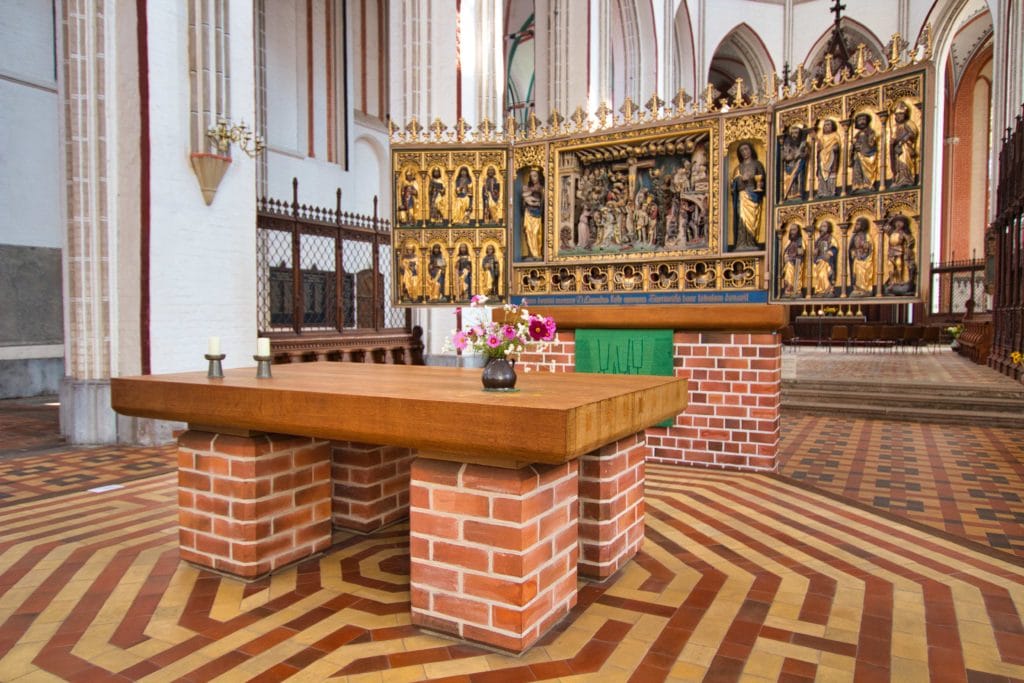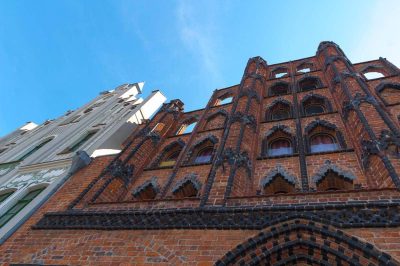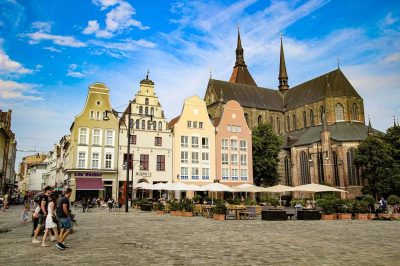With just under 100,000 inhabitants, Schwerin is not only Germany’s smallest state capital, but definitely also the coziest in the country. Schwerin was the residence of the dukes and grand dukes of Mecklenburg for a long time, and as befits a residential city, there is a magnificent building on almost every corner here. A pretty old town, surrounded on all sides by water, Hanseatic flair and of course the world-famous castle make Schwerin an ideal destination for a short trip to the northwest of Mecklenburg-Vorpommern. In the following article we would like to introduce you to the most beautiful Schwerin sights and give you a few tips to plan your trip optimally.
These are the most beautiful sights in Schwerin Germany
Market Square
Where better to start a tour than on the market square in front of the tourist information office? The chic houses have been extensively renovated in recent years. The snow-white building on the north side of the market square is the former market hall. It was once built because the duke found the hustle and bustle of the marketplace too colorful and wanted to concentrate trade in one place. It didn’t quite work out that way, but a beautiful market still takes place here on Wednesdays and Fridays in front of the market hall with its portico.
Monument to Henry the Lion
However, the most interesting place on the market square is a few meters in front of the market hall. Here stands a monument to the city’s founder Henry the Lion, which has caused quite a stir in the past. The South German artist Peter Lenk has really created something unusual here. Or have you ever seen a monument that mocks the man it is supposed to commemorate? At least I don’t know any where people show their naked butts to a king …

Schwerin Cathedral
From the market square, you can already see the massive cathedral with its steeple, the highest in Mecklenburg-Vorpommern. It is exactly 117.5 meters high and thus 50 cm higher than the Petrikirche in Rostock – after all, we are in the state capital here. From the gallery in the church tower, you have a great view over the city and, in good weather, all the way to the Baltic Sea. The church itself is much older than its tower from the 19th century and one of the most important buildings of the brick Gothic in Northern Germany. From the outside, the red-brown bricks look a bit like those of a castle. You are all the more surprised when you enter the church, because suddenly everything shines in white.
Inside the church you will find numerous works of art of inestimable value, including the Loste retable, a 15th-century altar made of sandstone, ornate tombs of the Dukes of Mecklenburg and an organ by Friedrich Ladegast, the most important German organ builder of the 19th century. The cathedral is also historically interesting because thousands of demonstrators gathered here in 1989 to peacefully protest the government of the GDR as part of the Monday demonstrations.
Old Town
The market square and the cathedral are certainly the most prominent buildings in the old town, but actually it is nicest to just drift through the alleys with their many small stores and cafes. Sometimes you see old half-timbered houses, sometimes magnificent buildings from the 19th century, like the imperial post office in Mecklenburg Street, in any case there is something to discover at every corner. And if you’re wondering about the huge flower tubs that are everywhere here: They are a reminder of the Federal Garden Show (Bundesgartenschau), which took place in Schwerin in 2009.

Schwerin Castle
Schwerin Castle is the city’s most important landmark and is known far beyond the borders of Mecklenburg-Vorpommern. It stands on a small island on the remains of an old Slavic fortification and is probably one of the most photogenic buildings in Germany. Today, the state parliament of Mecklenburg-Western Pomerania has its seat here, among other things, and the Grand Dukes of Mecklenburg used to live here.
The fairy-tale castle has been rebuilt again and again over the centuries, owing its current appearance to remodeling work by Georg Adolf Demmler, to whom the city owes its current appearance. In the 19th century he created numerous public buildings in Schwerin, most of which have survived to this day. Today you can stroll through the palace garden and the parks south of the island, relax in the palace café in the former orangery or go on a tour of the palace. I recommend the tour “From the cellar to the dome”, where you can see the castle from a completely different perspective.

Pfaffenteich and Lake Schwerin
Living by the water is one of the mottos which advertise Schwerin. And that is no exaggeration, because the city is surrounded by lakes almost everywhere. I liked the Pfaffenteich the best. It’s not particularly large, but it’s right in the center. It was once built as a carp pond and on its banks are some of the most beautiful buildings in the city. I especially liked Alexandrinenstraße on the west bank of the pond. Here, one wonderfully restored building follows the next, and the Arsenal is an impressive 136-meter-long building in the style of English Tudor Gothic. Today, the Ministry of the Interior of the state of Mecklenburg-Vorpommern is located here. Like the palace, the building was designed by Georg Adolf Demmler.
A fountain of water shoots up in the pond. The small “castle” on the other side is not a castle at all, but perhaps the most beautiful electricity plant in Germany. Today, however, electricity is no longer produced here, but concerts are held here from time to time. In summer, by the way, the Schwerin Dragon Boat Festival takes place on the pond. Then half the city is on its feet. In addition to the race, there are also colorful fireworks. So it’s worth it!
But what I like best about Pfaffenteich is the ferry named Petermännchenfähre. Here you can take perhaps the shortest and cheapest cruise in Germany for only 2 € and enjoy the city from the water.
Lake Schwerin is divided into a northern and a southern area and is located east of the castle. It is so large that you could almost think that Schwerin is also located by the sea. You can either walk along the shores of the lake, swim here in good weather or take a tour with the White Fleet, which takes you on two routes directly from the castle across the lake, allowing beautiful photo opportunities.

Open Air Museum Mueß
Tired of the city and longing for some country life? Then simply take streetcar 1, 2 or 3 to the Stauffenbergstraße stop and from there take bus No. 6 in the direction of Raben Steinfeld and get off at the open-air museum. Here you will find beautiful old houses that show you how people used to live in Mecklenburg. Everything looks as if the inhabitants had just left with their fishing boats, even a small village school is still standing here. Especially if you are traveling with children, the open-air museum Mueß is worth a visit.
Which tours are worth a try?
- With the Petermännchenfähre you can cross the Pfaffenteich north of the old town for only 2 €.
- The White Fleet (Weiße FLotte) takes you on a longer trip every day from 10:30 a.m. on various routes with the best view of the castle across Lake Schwerin.
- Every day at 11 a.m. in front of the tourist information on the market square, where you can also get the tickets for the tour, starts a nice, about one and a half hour city tour. Unfortunately, it is only available in German.
- The Bus Kontor shows you the most beautiful places of the city on a fixed route. In the double-decker bus, you will receive a lot of exciting information (in English as well) about Schwerin and its history during the approximately one-hour tour, which starts at the castle.
Where to eat and drink?
- Weinhaus Uhle, Schusterstraße 15. The beautiful Weinhaus Uhle has been around since 1751. Here is a nice restaurant with hotel, but especially the wine bistro I would like to recommend to you.
Where to stay overnight?
- Speicher am Ziegelsee*, Speicherstraße 11. Dass “Wohnen am Wasser” das Motto der Stadt ist, habe ich ja schon oben beschrieben. Hier trifft das zu 100 % zu, denn in dem alten Getreidespeicher könnt ihr direkt am kleinen Ziegelsee übernachten und wenn ihr wollt, sogar mit dem Boot anreisen!
- Zum Weißen Haus, Grunthalplatz 16. In the 19th century, Schwerin’s connection to the railroad network meant that a hotel was also needed for travelers, and this chic, now family-run hotel was created at the main train station. Besides the good location, the beautiful roof terrace is a big plus.
No products found.
No products found.
No products found.
No products found.



